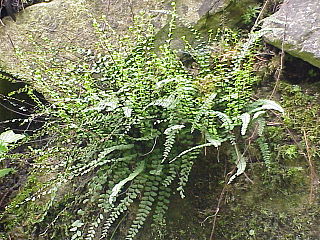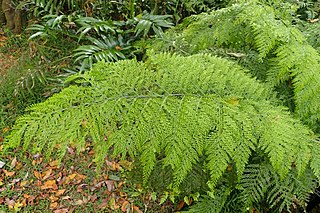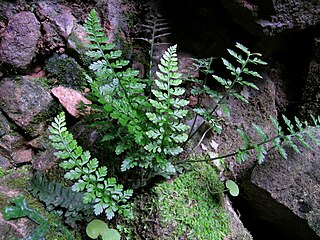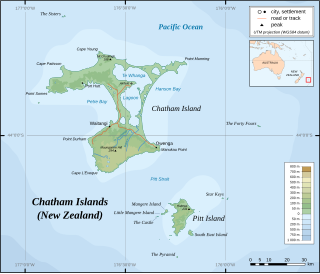
This article relates to the flora of New Zealand, especially indigenous strains. New Zealand's geographical isolation has meant the country has developed a unique variety of native flora. However, human migration has led to the importation of many other plants as well as widespread damage to the indigenous flora, especially after the advent of European colonisation, due to the combined efforts of farmers and specialised societies dedicated to importing European plants & animals.

Asplenium is a genus of about 700 species of ferns, often treated as the only genus in the family Aspleniaceae, though other authors consider Hymenasplenium separate, based on molecular phylogenetic analysis of DNA sequences, a different chromosome count, and structural differences in the rhizomes. The type species for the genus is Asplenium marinum.

Asplenium platyneuron, commonly known as ebony spleenwort or brownstem spleenwort, is a fern native to North America east of the Rocky Mountains. It takes its common name from its dark, reddish-brown, glossy stipe and rachis, which support a once-divided, pinnate leaf. The fertile fronds, which die off in the winter, are darker green and stand upright, while the sterile fronds are evergreen and lie flat on the ground. An auricle at the base of each pinna points towards the tip of the frond. The dimorphic fronds and alternate, rather than opposite, pinnae distinguish it from the similar black-stemmed spleenwort.

Asplenium bulbiferum, known as mother spleenwort, is a fern species native to New Zealand only. It is also called hen and chicken fern and, in the Māori language, pikopiko, mouku or mauku. Its fronds are eaten as a vegetable.

Asplenium rhizophyllum, the (American) walking fern, is a frequently-occurring fern native to North America. It is a close relative of Asplenium ruprechtii which is found in East Asia and also goes by the common name of "walking fern".

Asplenium trichomanes, the maidenhair spleenwort, is a small fern in the spleenwort genus Asplenium. It is a widespread and common species, occurring almost worldwide in a variety of rocky habitats. It is a variable fern with several subspecies.

Asplenium flaccidum is a species of fern in the family Aspleniaceae. The plant common name is drooping spleenwort or weeping spleenwort, and the species name flaccidum derives from the Latin root meaning drooping. An example occurrence of A. flaccidum is within a Nothofagus-Podocarp forest at Hamilton Ecological District on New Zealand's North Island in association with other fern species understory plants, crown fern, Blechnum discolor being an example.

Asplenium montanum, commonly known as the mountain spleenwort, is a small fern endemic to the eastern United States. It is found primarily in the Appalachian Mountains from Vermont to Alabama, with a few isolated populations in the Ozarks and in the Ohio Valley. It grows in small crevices in sandstone cliffs with highly acid soil, where it is usually the only vascular plant occupying that ecological niche. It can be recognized by its tufts of dark blue-green, highly divided leaves. The species was first described in 1810 by the botanist Carl Ludwig Willdenow. No subspecies have been described, although a discolored and highly dissected form was reported from the Shawangunk Mountains in 1974. Asplenium montanum is a diploid member of the "Appalachian Asplenium complex," a group of spleenwort species and hybrids which have formed by reticulate evolution. Members of the complex descended from A. montanum are among the few other vascular plants that can tolerate its typical habitat.

Asplenium bradleyi, commonly known as Bradley's spleenwort or cliff spleenwort, is a rare epipetric fern of east-central North America. Named after Professor Frank Howe Bradley, who first collected it in Tennessee, it may be found infrequently throughout much of the Appalachian Mountains, the Ozarks, and the Ouachita Mountains, growing in small crevices on exposed sandstone cliffs. The species originated as a hybrid between mountain spleenwort and ebony spleenwort ; A. bradleyi originated when that sterile diploid hybrid underwent chromosome doubling to become a fertile tetraploid, a phenomenon known as allopolyploidy. Studies indicate that the present population of Bradley's spleenwort arose from several independent doublings of sterile diploid hybrids. A. bradleyi can also form sterile hybrids with several other spleenworts.
Asplenium listeri, commonly known as the Christmas Island spleenwort, is a species of fern in the family Aspleniaceae. It is endemic to Christmas Island, an Australian territory in the northeastern Indian Ocean. Its specific epithet honours British zoologist and plant collector Joseph Jackson Lister, who visited the island on HMS Egeria in 1887 and was the first to collect a specimen.

Asplenium oblongifolium is a native species of fern from New Zealand. The plant's common name is shining spleenwort and its Māori name is huruhuruwhenua. A. oblongifolium is found on the North, South, Chatham and Kermadec Islands, and is found from the coast to the mountains.

Asplenium parvum is a plant in the spleenwort group of ferns. An epiphytic fern, seen growing on rocks and trees in tropical rainforests, usually at high altitude in Queensland. The specific epithet parvum is derived from latin, meaning "few or small". Described by Reverend Watts from a cultivated specimen growing in Gladesville, New South Wales. It first appeared in scientific literature in 1914 in the Linnean Society of New South Wales.

Asplenium appendiculatum, ground spleenwort, is a common native fern to Australia and New Zealand. It usually grows in cool damp conditions, among rocks, on logs or as an epiphyte.

Asplenium hookerianum, commonly known as Hooker's spleenwort, rocklax and maidenhair fern, is a small fern native to New Zealand and Australia.

Asplenium gracillimum is a fern species native to Australia and New Zealand, also found in Stewart Island and the Chatham Islands. The specific epithet gracillimum refers to the slender and graceful appearance of this fern.

Patrick John Brownsey was a British-born New Zealand botanist who specialised in the systematics of New Zealand ferns, and was for 44 years curator of botany at the National Museum of New Zealand and Te Papa.

Asplenium cimmeriorum, commonly known as the cave spleenwort, is a species of small fern in the family Aspleniaceae. Endemic to New Zealand, they are only found in the western coasts, from Waitomo in the North Island, to Punakaiki in the South Island. It grows in dark environments with high rainfall, such as cave walls and ceilings, and in the South Island, on rotting logs. The species was first described by Patrick Brownsey and Peter de Lange in 1997.

Although over 650 km (400 mi) from the main islands, the flora of the Chatham Islands is largely similar to the rest of New Zealand. About 400 of the 875 taxa attested in the Chatham Islands are indigenous to them; of these, only 47 are endemic to the islands. The endemic plants of the islands are divided between taxa related to those on the North Island and those with stronger links to the South Island and the subantarctic islands of New Zealand. The flora of the Chatham Islands were described from samples in the mid-1800s by botanists Joseph Hooker and Ferdinand von Mueller, neither of whom ever visited the islands, while Leonard Cockayne provided the first comprehensive Chatham Islands Flora in the early 1900s. The islands have become highly noted for their flora and fauna, attracting ecotourists. One endemic, the Chatham Islands forget-me-not, has become a botanical symbol of the islands due to its widespread cultivation in and outside New Zealand.

Asplenium obtusatum, the shore spleenwort or paranako, is a species of spleenwort found in New Zealand and other Pacific isles.


















